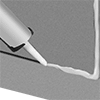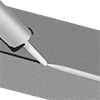Filter by
For Use With
For Use On
Maximum Temperature
Maximum Pressure for Gases
Maximum Pressure for Fluids
Cure Type
Minimum Temperature
Food Industry Standard
Environment
Manufacturer
Container Size
Military Specification
DFARS Specialty Metals
About Sealant Flexibility
More





































